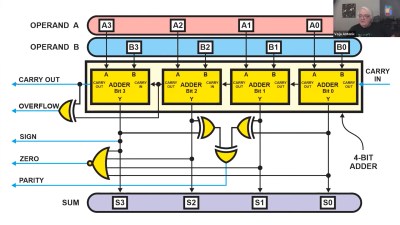[Voja Antonic] has been building digital computers since before many of us were born. He designed with the Z80 when it was new, and has decades of freelance embedded experience, so when he takes the time to present a talk for us, it’s worth paying attention.
For his Remoticon 2022 presentation, he will attempt to teach us how to become a hardware expert in under forty minutes. Well, mostly the digital stuff, but that’s enough for one session if you ask us. [Voja] takes us from the very basics of logic gates, through combinatorial circuits, sequential circuits, finally culminating in the description of a general-purpose microprocessor.

As he demonstrates, complex digital electronics systems really are just built up in a series of steps of increasing complexity. starting with individual active elements (transistors operating as switches) forming logic elements capable of performing simple operations.
From there, higher level functions such as adders can be formed, and from those an ALU and so on. Conceptually, memory elements can be formed from logic gates, but it’s not the most efficient way to do it, and those tend to be made with a smaller and faster circuit. But anyway, that model is fine for descriptive purposes.
Once you have combinatorial logic circuits and memory elements, you have all you need to make the necessary decoders, sequencers and memory circuits to build processors and other kinds of higher complexity circuits.
Obviously forty minutes isn’t anywhere nearly enough time time to learn all of the intricacies of building a real microprocessor like the pesky details of interfacing with it and programming it, but for getting up the learning curve from just a knowledge of binary numbers to an understanding of how a CPU is built, it’s a pretty good starting point.
Now, If you can only tear your eyes away from his slick game-of-life wall mounted LED display, you might pick up a thing or two.















Thanks that was an awesome presentation. I really like the effort for making it. With all that demos and stuff. The batch also looks cool
Enjoyed the presentation. Neat to show how from simple circuits, you build a more complex part, and then treat as a ‘black box’ to build a more complex part and treat that as a black box, and so on. Only way to manage the ‘complexity’. At least to me (I probably have a small mind), it is mind blowing looking in to what can be built that actually works ‘reliably’ for years 24×7 at such a small scale (microprocessors of today).
This was an interesting talk. Reminds me very much of the Nand2Tetris course.
Yeah, right! What I like about both is the way the complexity kinda sneaks up on you. Like adding in binary isn’t all that strange once you realize it’s an xor and carry. And then, switching seems plausble, and then all of a sudden you have an ALU…
Yeah, I’ve been educating myself about the basics of logic and processor design, and this was another great tool to help solidify that knowledge. Planning on getting a Tang Primer after the Chinese New Year and working through Nand2Tetris.
Or this one: https://nandgame.com/
Fascinating talk, I love to see how complicated machinery can be built from the ground up by using very simple blocs and rules, and this might be the most beautiful example possible (but I’m partial, since of course I love electronics). Too bad the end of the presentation is a bit rushed, but of course I understand the planning constraints, moreover this is a complicated subject that could fill semesters worth of lessons. The slides are very clear and the small breadboard demonstrations help tie everything to actual hardware, which is great.
Right now I’m pausing to try to understand every added block at each slide, but this would be well worth a 2-hour extended version if you ever wanted to make one !
It’s always mind-blowing trying to imagine how a simple Hello World in Python will translate into billions of precisely switching signals in what is basically a bunch of simple N and P mosfets. And I’m not even talking about actually showing that on a screen, which is a whole other thing again.
what is the board behind him? led?
perhaps two p2.5 320x160mm LED panels together?
It’s built of nine P6 32×32 pixels RGB panel and a custom controller.
https://hackaday.io/project/178482-game-of-life-as-a-wall-poster